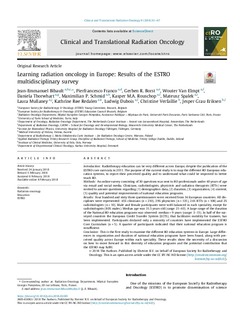| dc.contributor.author | Bibault, Jean-Emmanuel | |
| dc.contributor.author | Franco, Pierfrancesco | |
| dc.contributor.author | van Elmpt, Wouter | |
| dc.contributor.author | Thorwarth, Daniela | |
| dc.contributor.author | Schmid, Maximilian P | |
| dc.contributor.author | Rouschop, Kasper M | |
| dc.contributor.author | Spalek, Mateusz | |
| dc.contributor.author | Mullaney, Laura | |
| dc.contributor.author | Redalen, Kathrine | |
| dc.contributor.author | Dubois, Ludwig | |
| dc.contributor.author | Verfaille, Christine | |
| dc.contributor.author | Eriksen, Jesper Grau | |
| dc.date.accessioned | 2019-01-03T15:00:22Z | |
| dc.date.available | 2019-01-03T15:00:22Z | |
| dc.date.created | 2019-01-02T00:08:59Z | |
| dc.date.issued | 2018 | |
| dc.identifier.citation | Clinical and Translational Radiation Oncology. 2018, 9 61-67. | nb_NO |
| dc.identifier.issn | 2405-6308 | |
| dc.identifier.uri | http://hdl.handle.net/11250/2579065 | |
| dc.description.abstract | Introduction
Radiotherapy education can be very different across Europe, despite the publication of the ESTRO core curricula in 2011. The purpose of the current study is to map the different RO European education systems, to report their perceived quality and to understand what could be improved to better teach RO.
Methods
An online survey consisting of 30 questions was sent to RO professionals under 40 years of age via email and social media. Clinicians, radiobiologists, physicists and radiation therapists (RTTs) were invited to answer questions regarding (1) demographics data, (2) duration, (3) organization, (4) content, (5) quality and potential improvements of national education programs.
Results
Four hundred and sixty three questionnaires were received from 34 European countries. All disciplines were represented: 45% clinicians (n = 210), 29% physicists (n = 135), 24% RTTs (n = 108) and 2% radiobiologists (n = 10). Male and female participants were well-balanced in each speciality, except for radiobiologists (80% males). Median age was 31.5 years old (range 21–40). A large range of the duration of the National RO education programs was observed: median = 9 years (range: 3–15). In half of the surveyed countries the European Credit Transfer System (ECTS), that facilitates mobility for trainees, has been implemented. Participants declared only a minority of countries have implemented the ESTRO Core Curriculum (n = 5). A quarter of participants indicated that their national education program is insufficient.
Conclusion
This is the first study to examine the different RO education systems in Europe. Large differences in organization and duration of national education programs have been found, along with perceived quality across Europe within each speciality. These results show the necessity of a discussion on how to move forward in this diversity of education programs and the potential contribution that the ESTRO may fulfil. | nb_NO |
| dc.language.iso | eng | nb_NO |
| dc.publisher | Elsevier | nb_NO |
| dc.relation.uri | https://www.ctro.science/article/S2405-6308(18)30012-0/fulltext | |
| dc.rights | Attribution-NonCommercial-NoDerivatives 4.0 Internasjonal | * |
| dc.rights.uri | http://creativecommons.org/licenses/by-nc-nd/4.0/deed.no | * |
| dc.title | Learning radiation oncology in Europe: Results of the ESTRO multidisciplinary survey | nb_NO |
| dc.type | Journal article | nb_NO |
| dc.type | Peer reviewed | nb_NO |
| dc.description.version | publishedVersion | nb_NO |
| dc.source.pagenumber | 61-67 | nb_NO |
| dc.source.volume | 9 | nb_NO |
| dc.source.journal | Clinical and Translational Radiation Oncology | nb_NO |
| dc.identifier.doi | 10.1016/j.ctro.2018.02.001 | |
| dc.identifier.cristin | 1648118 | |
| dc.description.localcode | This is an open access article under the CC BY-NC-ND license (http://creativecommons.org/licenses/by-nc-nd/4.0/). | nb_NO |
| cristin.unitcode | 194,66,20,0 | |
| cristin.unitname | Institutt for fysikk | |
| cristin.ispublished | true | |
| cristin.fulltext | original | |
| cristin.qualitycode | 1 | |

